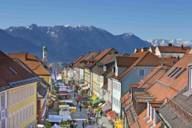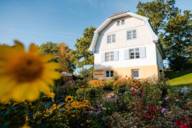
Murnau is immensely picturesque. Many of the views are preserved in the paintings of the artists of the Blauer Reiter (Blue Rider), who settled here at the beginning of the 19th century. Even today, you can tread in their footsteps and discover the Murnauer Moos nature reserve, old craft traditions, cosy cafés and inns for a break.
- The history of Murnau
- The castle museum – the former Murnau Castle
- Explore the nature around Murnau
- Discover Murnau on theme trails and guided tours
- Tips for inns and cafés in Murnau
- Murnau: How to get there from Munich
Murnau was first mentioned in documents around the year 1150. The community belonged to the domain of the Prince-Bishop of Augsburg. Due to its location on the trade route between Upper Italy and Augsburg, it was a trans-shipment point from the beginning and could call itself a market. In 1332, Murnau Castle and the surrounding estates went to Emperor Ludwig the Bavarian, who transferred the administration of the town to the Ettal Monastery.
Until secularisation in 1803, the small town was the economic centre of the Werdenfelser Land and the Zugspitz region. With its connection to the railway, the first spa guests arrived at the end of the 19th century. In 1920, Ödon von Horváth also discovered Murnau as a place for his summer retreat. From 1924 onwards, he spent almost the entire year here. A small exhibition in the castle museum is dedicated to the writer and his connection to Murnau.
The castle owes its characteristic appearance with the white façade and the battlements on the gables to the additions made in the 16th century. Archaeological investigations have shown that the medieval residential tower of the former core castle was probably built between 1230 and 1240. The Ettal judges had their official residence here until the beginning of the 19th century.
After many years of use as a school and residential building, the Schloßmuseum Murnau moved in at the beginning of the 1990s. It is one of the must-see art museums in the Munich area. The painters of Blauer Reiter, above all Gabriele Münter, impressively immortalised views of the town of Murnau and its surroundings in paintings. Münter writes that in Murnau she made the leap from pure “depiction of nature“ to abstraction.
This development becomes clear when viewing the approximately 80 paintings, drawings and graphics on display. In addition, there is the fantastic alpenglow, captured in Alexej von Jawlensky's painting “Landschaft bei Murnau” (Landscape near Murnau) and numerous works by Wassily Kandinsky, Franz Marc, Marianne von Werefkin, Alexander Kanoldt, Heinrich Campendonk, Erma Bossi and Adolf Erbslöh, but also by Max Beckmann and other artists.
The Murnau region was known far beyond its borders for the traditional craft of reverse glass painting. Many modern and contemporary artists also used this technique as a special form of artistic expression. In addition to regional exhibits from the Staffelsee (lake) region and Augsburg, the museum shows international reverse glass painting and works by Paul Klee, Oskar Schlemmer, August Macke and Gabriele Münter, as well as Gerhard Richter and Rupprecht Geiger.

One of the museum's windows offers a view of the Münter House, where the artist lived until her death in 1962 and also spent several years with Wassily Kandinsky. Here, important preparations were made for the founding of the Blauer Reiter artists' group. The villa with paintings and original furniture painted by Kandinsky is also open for visitors. The grave of Gabriele Münter (1877-1962) is in the local cemetery, where she found her final resting place together with her long-time partner Johannes Eichner.
Everything in Murnau is in a prime location: Whether it's at the grave of the famous painter, over coffee and cake on the terrace of the castle museum, in the Fußgängerzone (pedestrian zone) or even in the car park of the local supermarket, everywhere there is an overwhelming view far across the mountainscape of the Ester and Mangfall mountains, all the way to the Zugspitze (mountain).
On the western outskirts of the village, the Staffelsee invites you to swim or go for long walks. A 22-kilometre signposted cycling and hiking trail leads around the entire lake. You can shorten the route by taking a boat for part of the way. The boat season on the Staffelsee is from April to October. A special highlight here are the moonshine cruises with music on board.
The Murnauer Moos in the south of the city is the largest enclosed moorland in Central Europe and worth seeing at any time of year. Blue irises bloom in spring, followed by pink and purple orchids in early summer and rust-red grasses in autumn. An exploration of this biotope with trained hiking and mountain guides is particularly rewarding.
Murnau and the surrounding region can easily be explored on your own. The extensively signposted theme trails through the town and the surrounding area are a great help. A literary walk in the footsteps of Ödon von Horváth or a foray to the places where Gabriele Münter worked, are two examples of the activities on offer.
The most beautiful viewpoints of the so-called Blaues Land around Murnau can be reached via the “Königsweg” (king’s walking trail). The Murnau guides will be happy to accompany you on one of these cultural trails, or you can take part in a classic guided tour of the old town, designed by the Munich architect Emanuel von Seidl (1856-1919).
In Murnau, fine beer is brewed and served with typical Bavarian dishes. Beer tastings are offered at the Bräustüberl (traditional bavarian restaurant) of the traditional Karg brewery or at the Griesbräu brewery. The Krönner empire with its coffee house and manufactory is a good choice for cakes and chocolates.
A speciality at Café Krönner is the Agnes Bernauer cake, a heavenly mocha-buttercream-nut meringue cake named after the unfortunate barber's daughter who was sentenced to death by her husband Duke Albrecht in 1411 for alleged witchcraft and drowned in the Danube.
The coffee served with the cake comes from the Murnau coffee roastery, which also runs its own coffee shop. Gelateria Gabbrielli on Untermarkt does not have its own website, but it is easy to recognise from the often long queue in front of the ice cream parlour on Untermarkt. It's worth the wait, because here you can probably get the best ice cream in the area – crowned by an unbeatable Alpine panorama.
Train connection: approx. 1 hour. Information at bahn.de
Car: approx. 1 hour via the A95 motorway